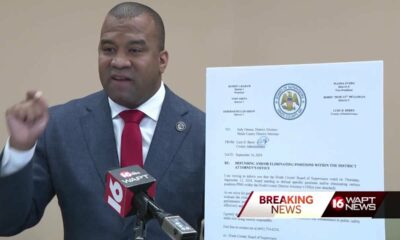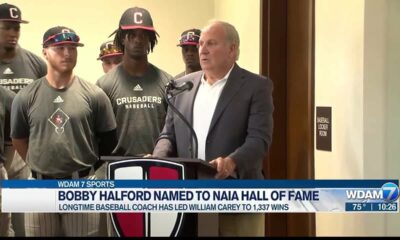Mississippi Today
Mississippi regulators to solar boosters: Sit down and be quiet

Kyle Wallace sat in the audience with his hand raised earlier this month so he could speak during an open discussion at the Mississippi Public Service Commission’s Solar Summit.
Wallace, an executive with the New Orleans-based rooftop solar developer, PosiGen, wanted to share information about solar energy with the relatively fresh-faced regulators. All three said earlier in the day they had many questions about how the renewable fuel would fit in in Mississippi, which still gets most of its electricity from fossil fuels.
But after another speaker, Brent Bailey, a former Republican Public Service Commissioner who advocated for clean energy and who now works for a local solar and energy efficiency company spoke, the commissioners cut off comments from that side of the room — abruptly ending the chance for any solar advocate or industry representative to speak.
“We want to hear from people who are not selling solar panels,” said De’Keither Stamps, a Democrat and a former state lawmaker who was elected to the commission last year.
Chairman Chris Brown backed him up.
“We’re turning into an infomercial,” said Brown, a Republican who also was elected to the three-member PSC last year after serving in the state House of Representatives.
Said Wallace: “We were sitting there in the audience thinking, ‘We have answers to these (questions); these are not new questions.’ We want to be able to address them, but we just weren’t provided the opportunity.”
In fact, the agenda for the Aug. 15 meeting included no one from the solar or clean energy industry. Serving in the role as an expert at the summit was a representative of the Texas Public Policy Foundation, a right-wing think tank funded by the oil and gas industry that is adept at spreading its anti-renewable agenda nationwide.
Stamps later defended shutting down the pro-solar voices at the summit: “It was a question-and-answer period,” he told Floodlight. “It wasn’t a ‘give-your-speech’ period.”
Keeping clean energy advocates out of the conversation is just one of a series of tactics the commission has used to discourage solar development in the Magnolia State. Earlier this year, the commission halted rules that would have made rooftop solar more affordable for homeowners and institutions including schools.
The Aug. 15 discussion comes at a time when climate change is approaching a tipping point, and the Biden Administration’s Inflation Reduction Act (IRA) has rolled out billions in tax breaks for clean energy to cut economy-wide carbon emissions 40% by 2030.
Lots of sun — but little solar
Mississippi is the 13th sunniest state in the United States. But when it comes to solar, the state ranks 37 out of 50, according to the Solar Energy Industries Association, an industry trade group.
Mississippi’s neighbors in the South aren’t faring much better. Alabama ranks 32; Arkansas, 27; Louisiana is at 36, and Tennessee, 30. All figures are according to SEIA.
Wallace said the PSC staff member who was handing a microphone to audience members stopped walking toward where he and other environmental advocates were sitting. They all put their hands down.
He said members of the solar industry had been reaching out to the commissioners all year to help them understand the industry and the impacts of their policymaking on the future of solar in the state.
“It was disappointing,” Wallace said in an interview with Floodlight. “We had hoped that it would be more of an opportunity to have a dialogue and really engage. It obviously did not turn out that way.”
Policy expert is fossil fuel lobbyist
Those invited to speak were executives from the politically influential Mississippi Power Co., the Tennessee Valley Authority, the state’s agriculture and commerce commissioner and Brent Bennett, a policy director from the conservative Texas Public Policy Foundation.
Bennett noted that most new power generation is coming from wind and solar. He said that correlates with higher electrical prices in California and Texas, where adoption of renewables has been higher than most states.
“For anyone that’s wanting to add more wind and solar to their resource mix, I think there’s a burden of proof there to show that, ‘OK, well, if you’re going to do that, how are you going to keep costs down?’ ” he said.
But pieces of that puzzle have been studied. A December 2023 report from the consulting firm Ernst & Young found the cost of producing and moving solar electricity over the life of the panels is roughly 29% lower than the cheapest fossil fuel.
Bennett’s track record for creating barriers to renewable energy can be seen in a sweeping energy law the Texas Legislature passed in 2023. According to the Guardian, Bennett edited several amendments to the bill, which doles out incentives for new plants that burn natural gas, also known as methane.
The edits included adding new transmission costs on renewables as well as a requirement that developers ensure wind and solar — intermittent sources of electricity — have access to backup power from fossil fuels, according to the Guardian.
Monika Gerhart, executive director of the Gulf States Renewable Energy Industries Association, said a lot of the information shared at the meeting “raised some real red flags.”
She added, “Everyone wants progress in innovation, and I’m not sure this summit was designed to meet those needs.”
Stamps said the meeting was a first step and wasn’t set up, “to solve all of the problems in one day.”
“It was just the start of the discussion, build some relationships, people can see people,” he said in an interview with Floodlight. “The anti people can come and be in the same room as the pro people … just put everybody in the same room together.”
When asked to respond to his comment regarding a desire to hear from people who weren’t selling solar panels, Stamps said that he’s allowed Bailey — his opponent in two previous PSC elections — and others from the industry to speak about solar on other occasions.
Solar faces political winds
Roughly 20 solar companies are based in Mississippi. The bulk of the solar installations there are in large — or so-called utility-scale — projects. Electric utilities prefer these projects for two reasons: they operate similar to existing power plants, and they can own them, which beefs up their bottom line.
On the flip side, these utilities are resistant — or even take steps to block — customers using rooftop solar because it is disruptive to the industry’s business model. The companies typically use an argument known as “cost shifting,” saying that rooftop solar customers depend less on the power grid, thus driving up the costs that others have to pay for that infrastructure.
Indeed, solar on homes and businesses in Mississippi barely shows up on a SEIA graphic of annual solar installations.

In 2015, the Mississippi PSC adopted a rooftop solar policy to make it more affordable for residents and small businesses. The rule was a top priority of then-veteran regulator Brandon Presley, a widely popular Democrat who ran unsuccessfully to unseat Republican Gov. Tate Reeves last year.
Presley, who also authored the PSC’s policy to boost energy efficiency, was behind a revamped rule in 2022 that offered rebates for home solar systems for low-income households as well as increased the amount they would receive for selling excess electricity back to the grid.
The new rule also created incentives for schools to install rooftop solar to decrease their annual energy expenses.
But the commission gutted that policy earlier this year, arguing that incentives through the IRA’s Solar for All program, administered by the U.S. Environmental Protection Agency, would make it easier for low-income residents to put solar on their roofs. The 2-1 vote happened without public notice or an opportunity to comment on the issue beforehand.
The Sierra Club, whose lobbyists are active in fighting anti-renewable energy policies at the PSC and at the Mississippi statehouse, sued the PSC in May, arguing the action should be rescinded because of the lack of notice.

During the summit, Gerhart was among the attendees who pointed out that regulators did not use the full hour-long time block allotted for discussion. The summit was running ahead of schedule, a rarity in any state utility regulatory meeting, so there could have been even more time to hear from members of the audience.
“So most of the industry folks who actually have valuable and factual information to share have sat here all day waiting for this public comment,” she told Floodlight. “They said that they didn’t want to hear from the industry, and then they shut it down.”
Floodlight is a nonprofit newsroom that investigates the powerful interests stalling climate action.
This article first appeared on Mississippi Today and is republished here under a Creative Commons license.
Mississippi Today
A Mississippi town moves a Confederate monument that became a shrouded eyesore
GRENADA (AP) — A Mississippi town has taken down a Confederate monument that stood on the courthouse square since 1910 — a figure that was tightly wrapped in tarps the past four years, symbolizing the community’s enduring division over how to commemorate the past.
Grenada’s first Black mayor in two decades seems determined to follow through on the city’s plans to relocate the monument to other public land. A concrete slab has already been poured behind a fire station about 3.5 miles (5.6 kilometers) from the square.
But a new fight might be developing. A Republican lawmaker from another part of Mississippi wrote to Grenada officials saying she believes the city is violating a state law that restricts the relocation of war memorials or monuments.
The Grenada City Council voted to move the monument in 2020, weeks after police killed George Floyd in Minneapolis. The vote seemed timely: Mississippi legislators had just retired the last state flag in the U.S. that prominently featured the Confederate battle emblem.
The tarps went up soon after the vote, shrouding the Confederate soldier and the pedestal he stood on. But even as people complained about the eyesore, the move was delayed by tight budgets, state bureaucracy or political foot-dragging. Explanations vary, depending on who’s asked.
A new mayor and city council took office in May, prepared to take action. On Sept. 11, with little advance notice, police blocked traffic and a work crew disassembled and removed the 20-foot (6.1-meter) stone structure.
“I’m glad to see it move to a different location,” said Robin Whitfield, an artist with a studio just off Grenada’s historic square. “This represents that something has changed.”
Still, Whitfield, who is white, said she wishes Grenada leaders had invited the community to engage in dialogue about the symbol, to bridge the gap between those who think moving it is erasing history and those who see it as a daily reminder of white supremacy. She was among the few people watching as a crane lifted parts of the monument onto a flatbed truck.
“No one ever talked about it, other than yelling on Facebook,” Whitfield said.
Mayor Charles Latham said the monument has been “quite a divisive figure” in the town of 12,300, where about 57% of residents are Black and 40% are white.
“I understand people had family and stuff to fight and die in that war, and they should be proud of their family,” Latham said. “But you’ve got to understand that there were those who were oppressed by this, by the Confederate flag on there. There’s been a lot of hate and violence perpetrated against people of color, under the color of that flag.”
The city received permission from the Mississippi Department of Archives and History to move the Confederate monument, as required. But Rep. Stacey Hobgood-Wilkes of Picayune said the fire station site is inappropriate.
“We are prepared to pursue such avenues that may be necessary to ensure that the statue is relocated to a more suitable and appropriate location,” she wrote, suggesting a Confederate cemetery closer to the courthouse square as an alternative. She said the Ladies Cemetery Association is willing to deed a parcel to the city to make it happen.
The Confederate monument in Grenada is one of hundreds in the South, most of which were dedicated during the early 20th century when groups such as the United Daughters of the Confederacy sought to shape the historical narrative by valorizing the Lost Cause mythology of the Civil War.
The monuments, many of them outside courthouses, came under fresh scrutiny after an avowed white supremacist who had posed with Confederate flags in photos posted online killed nine Black people inside the historic Emanuel African Methodist Episcopal Church in Charleston, South Carolina, in 2015.
Grenada’s monument includes images of Confederate president Jefferson Davis and a Confederate battle flag. It was engraved with praise for “the noble men who marched neath the flag of the Stars and Bars” and “the noble women of the South,” who “gave their loved ones to our country to conquer or to die for truth and right.”
A half-century after it was dedicated, the monument’s symbolism figured in a voting rights march. When the Rev. Martin Luther King Jr. and other civil rights leaders held a mass rally in downtown Grenada in June 1966, Robert Green of the Southern Christian Leadership Conference scrambled up the pedestal and planted a U.S. flag above the image of Davis.
The cemetery is a spot Latham himself had previously advocated as a new site for the monument, but he said it’s too late to change now, after the city already budgeted $60,000 for the move.
“So, who’s going to pay the city back for the $30,000 we’ve already expended to relocate this?” he said. “You should’ve showed up a year and a half ago, two years ago, before the city gets to this point.”
A few other Confederate monuments in Mississippi have been relocated. In July 2020, a Confederate soldier statue was moved from a prominent spot at the University of Mississippi to a Civil War cemetery in a secluded part of the Oxford campus. In May 2021, a Confederate monument featuring three soldiers was moved from outside the Lowndes County Courthouse in Columbus to another cemetery with Confederate soldiers.
Lori Chavis, a Grenada City Council member, said that since the monument was covered by tarps, “it’s caused nothing but more divide in our city.”
She said she supports relocating the monument but worries about a lawsuit. She acknowledged that people probably didn’t know until recently exactly where it would reappear.
“It’s tucked back in the woods, and it’s not visible from even pulling behind the fire station,” Chavis said. “And I think that’s what got some of the citizens upset.”
This article first appeared on Mississippi Today and is republished here under a Creative Commons license.
Crooked Letter Sports Podcast
Podcast: New Orleans sports columnist and author Jeff Duncan joins the podcast to talk about his new Steve Gleason book and the new-look New Orleans Saints.
Jeff Duncan went from the Mississippi Book Festival in Jackson on Saturday to Jerry World in Dallas on Sunday where he watched and wrote about the Saints’ total dismantling of the Dallas Cowboys. We talk about both events and also about what happened in high school and college football last weekend and what’s coming up this weekend.
Stream all episodes here.
This article first appeared on Mississippi Today and is republished here under a Creative Commons license.
Mississippi Today
On this day in 1899
Sept. 18, 1899

Scott Joplin, known as “the King of Ragtime,” copyrighted the “Maple Leaf Rag,” which became the first song to sell more than 1 million copies of sheet music. The popularity launched a sensation surrounding ragtime, which has been called America’s “first classical music.”
Born near Texarkana, Texas, Joplin grew up in a musical family. He worked on the railroad with other family members until he was able to earn money as a musician, traveling across the South. He wound up playing at the World’s Fair in Chicago in 1893, where he met fellow musician Otis Saunders, who encouraged him to write down the songs he had been making up to entertain audiences. In all, Joplin wrote dozens of ragtime songs.
After some success, he moved to New York City, hoping he could make a living while stretching the boundaries of music. He wrote a ragtime ballet and two operas, but success in these new forms eluded him. He was buried in a pauper’s grave in New York City in 1917.
More than six decades later, his music was rediscovered, initially by Joshua Rifkin, who recorded Joplin’s songs on a record, and then Gunther Schuller of the New England Conservatory, who performed four of the ragtime songs in concert: “My faculty, many of whom had never even heard of Joplin, were saying things like, ‘My gosh, he writes melodies like Schubert!’”
Joplin’s music won over even more admirers through the 1973 movie, “The Sting,” which won an Oscar for the music. His song, “The Entertainer,” reached No. 3 on Billboard and was ranked No. 10 among “Songs of the Century” list by the Recording Industry Association of America. His opera “Treemonisha” was produced to wide acclaim, and he won a Pulitzer Prize in 1976 for his special contribution to American music.
“The ragtime craze, the faddish thing, will obviously die down, but Joplin will have his position secure in American music history,” Rifkin said. “He is a treasurable composer.”
This article first appeared on Mississippi Today and is republished here under a Creative Commons license.
-
Mississippi News Video5 days ago
Woman arrested after reposting school threat in Calhoun County
-
News from the South - Louisiana News Feed5 days ago
Food drive underway for Hurricane Francine victims in Kenner
-
Mississippi Today2 days ago
On this day in 1925
-
News from the South - Kentucky News Feed4 days ago
The search for Joseph Couch intensifies
-
News from the South - Alabama News Feed2 days ago
Diddy Arrested In Manhattan | September 16, 2024 | News 19 at 10 p.m.
-
News from the South - Alabama News Feed4 days ago
Sylacauga Church welcomes Haitian migrants amid speculations
-
Mississippi Today3 days ago
Another Midwest drought is causing transportation headaches on the Mississippi River
-
News from the South - Florida News Feed6 days ago
Tropics update: Tropical Depression 7, 2 other disturbances brewing in Atlantic










































